home | internet service | web design | business directory | bulletin board | advertise | events calendar | contact | weather | cams

|
Sam Thrasher and her team Red Babe and Black Babe harrowing field across the highway from Doubletree Farm. 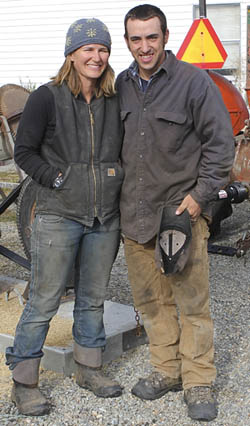 Sam Thrasher and Paul Soodak own and operate the horse-powered Doubletree Farm as well as Wildcat Excavating from their place south of Twisp. Sam Thrasher and Paul Soodak own and operate the horse-powered Doubletree Farm as well as Wildcat Excavating from their place south of Twisp.Small farming in the Methow PART EIGHT OF A SERIES Sam Thrasher and Paul Soodak are a rarity among the Methow Valley’s handful of hardworking small-scale farmers. As of a few weeks ago, theirs became a “closed loop” farm, which means the two of them and their numerous animals are essentially “self sufficient.” “I like growing all my own food,” says Thrasher. By sometime next year, she also plans to have a small dairy established so she can sell raw milk from her two Jersey cows and pork from the Heritage breed Tamworth pigs she raises, as well as beef from the Jersey/Angus calves that will be born to her dairy cows. She’ll add a third milk cow later. “I want to get things to where I want to do them and can… And I want to keep it so I like doing it,” says the 29-year-old Thrasher, who has been farming here since 2008. The couple’s horse-powered Doubletree Farm sits on a mere seven acres south of Twisp, although Thrasher grows alfalfa and grains on 15 acres of neighboring fields. Hers is the more public profile of the pair because she works the fields the old-fashioned way with two teams of traffic-stopping draft horses. It’s not uncommon for drivers to pull over and snap a few photographs. If she’s driving the white Percherons, that would be Salt on the right and Pepper on the left. They are the oldest pair and do the lighter work like harrowing and raking hay. “The Babes” do the heavier work of plowing, disking and mowing hay as well as some of the harrowing. Red Babe is a Belgian, and Black Babe a Percheron. 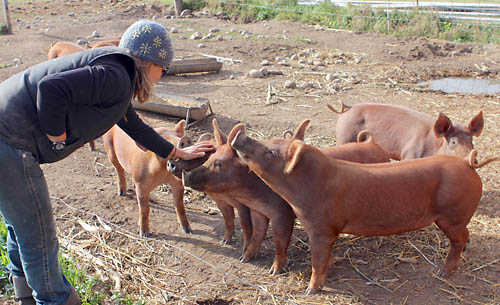 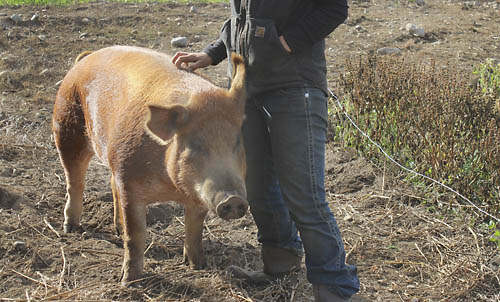 TOP: Some of Lulu’s nine friendly piglets seek attention from Sam Thrasher. They were born May 30. BOTTOM: Mama pig Lulu is a Tamworth, a heritage breed known for lean meat and lots of bacon. She had nine piglets this year. TOP: Some of Lulu’s nine friendly piglets seek attention from Sam Thrasher. They were born May 30. BOTTOM: Mama pig Lulu is a Tamworth, a heritage breed known for lean meat and lots of bacon. She had nine piglets this year.Work-shift length depends on the horses’ condition and the weather. But in general, Thrasher says that if they’re mowing hay, they work two-to-three acres at a time at the rate of about one acre an hour. “You have to stop and let them breathe and have a break,” she says. “I’ve worked them as much as six hours a day.” Thrasher, who’s been around horses all her life, learned to plow with them at a local weekend workshop. When she acquired her first team through bartering, they were put to work on the hay fields. All told, the Thrasher-Soodak collection of farm animals includes six horses—the two draft teams plus two saddle horses—two pregnant milk cows, Lulu the sow and her nine piglets, two sheep, a flock of about 20 chickens, three dogs and two cats. Most of them behave like beloved pets. “I’d have the horses living in the house, too, but Paul would probably throw me out,” Thrasher says with a laugh. The oldest of three girls, Thrasher grew up on 50 acres in Vermont, where her dad had an excavating business and her mother trained horses. Thrasher says that unlike her two sisters, as a child she was fascinated by heavy equipment and loved following her dad around. Eventually, she worked summers excavating for him. After studying welding at Eastern Wyoming College, Thrasher came to the Methow Valley in 2005. Her aunt, Bo Thrasher, lives in Mazama. She met Soodak, 31, who had a welding shop in the valley at the time. He grew up in New York at The Fellowship, “an intentional community” of people of all ages focused on caring for the elderly. “He grew all his own food,” Thrasher says of her husband’s time living at The Fellowship. Soodak also made his way to the valley because of an aunt, Agnes Almquist of Winthrop, and a cousin, Becky Studen of Twisp. 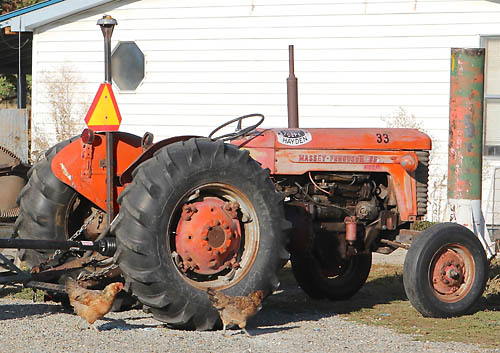 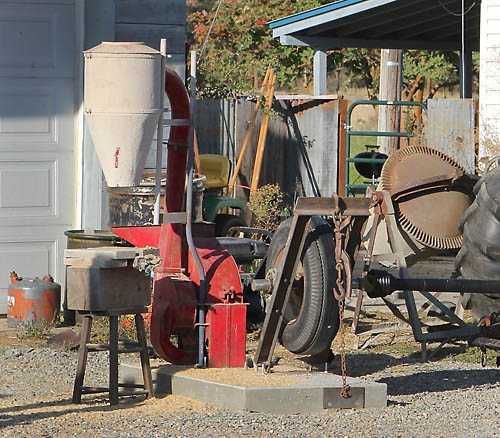 The chickens love to peck around the tractor because it drives the hammer mill Paul Soodak built to split the feed grain Thrasher grows for their animals. There is often spilled grain for the taking. The chickens love to peck around the tractor because it drives the hammer mill Paul Soodak built to split the feed grain Thrasher grows for their animals. There is often spilled grain for the taking.He found work excavating for Palm Construction. Thrasher was working for the late Ron Vanderyacht, who had a dairy on the East County Road north of Twisp. In 2007, Thrasher and Soodak bought an excavator and started the Wildcat Excavating Company. They both worked excavating jobs while developing their farm. An early morning fire in the spring of 2012 that destroyed their barn caused some serious soul searching and refocusing, Thrasher says. The blaze took Rosie, their beloved sow, and her 10 piglets, all their harness and tack, and a supply of hay. Because the fire was caused by heat lamps, a common source of warmth for baby farm animals and chicks, Thrasher vowed never to use them again. Her pigs now have a separate shelter designed to meet their needs. She also thought seriously about what the farm should be and what kind of barn they would need in the future. Thanks to the insurance settlement, they were able to buy materials to rebuild, and with the help of a friend and their own labor, they have a not-quite-finished new barn. “I never wanted to tarp hay again,” says Thrasher. This year she has grown and put up 30 tons of hay, all of which is stored under the new barn roof. Also, there is a tack room, a covered loafing area, and tie stalls for her large animals. The milking parlor is designed for three cows and there will be a milk room. One thing she’s eliminated from her plan is growing enough potatoes and other vegetables to sell as she once did at the Methow Valley Farmers Market in Twisp. Instead, the couple keeps a smaller garden that feeds their household and puts vegetables in the root cellar for winter. And while theirs is a self-sustaining farm, Thrasher says they buy some staples at the store—flour, cooking oil and coffee, for example, as well as extras like ice cream and beer. They also use some fossil fuel—a tractor for combining and baling the hay. The tractor also is what allowed Soodak to close their farm loop recently because it powers the hammer mill he designed and built to crack the feed grains. Running a small farm and an excavating business doesn’t leave a lot of extra time. There are always chores to do and projects to finish. But when asked what she and Soodak do in addition to work, three things sprang immediately to Thrasher’s mind: Ultimate Frisbee, backcountry skiing and horseback riding. It’s a satisfying life, she says, adding that she hopes to be farming into her 80s.
11/18/2013 Comments
|

 The not-quite-finished new barn built to replace the barn destroyed by fire in April 2012. That tragedy, which included loss of some animals, led to refocusing the farm.
The not-quite-finished new barn built to replace the barn destroyed by fire in April 2012. That tragedy, which included loss of some animals, led to refocusing the farm.